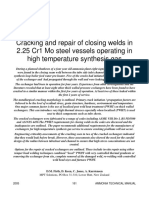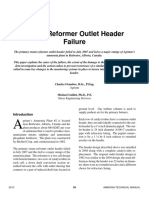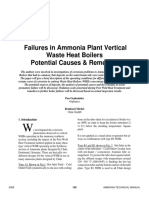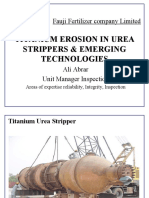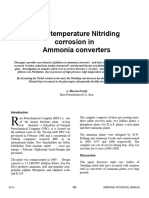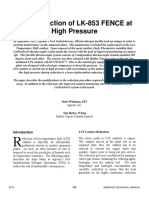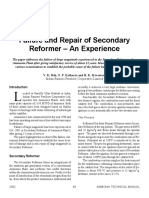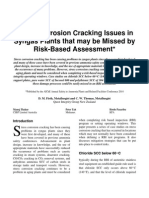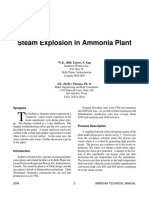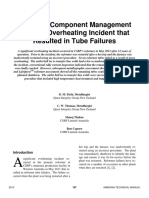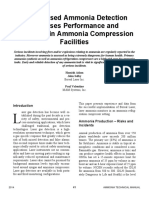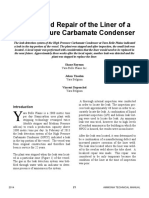Strange Operation Experience in Synloop Boiler Ends in Extensive Repair of Ammonia Converter Cartridge
Strange Operation Experience in Synloop Boiler Ends in Extensive Repair of Ammonia Converter Cartridge
Uploaded by
GrootCopyright:
Available Formats
Strange Operation Experience in Synloop Boiler Ends in Extensive Repair of Ammonia Converter Cartridge
Strange Operation Experience in Synloop Boiler Ends in Extensive Repair of Ammonia Converter Cartridge
Uploaded by
GrootOriginal Title
Copyright
Available Formats
Share this document
Did you find this document useful?
Is this content inappropriate?
Copyright:
Available Formats
Strange Operation Experience in Synloop Boiler Ends in Extensive Repair of Ammonia Converter Cartridge
Strange Operation Experience in Synloop Boiler Ends in Extensive Repair of Ammonia Converter Cartridge
Uploaded by
GrootCopyright:
Available Formats
Strange Operation Experience in
Synloop Boiler Ends in Extensive
Repair of Ammonia Converter
Cartridge
SAFCO operates the first single train 3300 MTPD Ammonia plant in the world. In January 2012, an
increase in pressure drop was noted at the first synthesis loop boiler downstream the first ammonia
converter. After a plant trip, the outlet temperature of this boiler increased without noted influence
on the steam production of the boiler. The outlet temperature and pressure drop partly recovered
after a power outage. During the turnaround in April 2012, an inspection of the boilers was carried
out. It was discovered that the experienced changes of operation in the boiler were related to a
material damage in the upstream ammonia converter. The damage resulted in an extensive repair
performed with available site personnel.
Reinhard Michel
ThyssenKrupp Uhde GmbH
Fahad Al Sawat
Saudi Arabian Fertilizer Company (SAFCO)
second single bed converter, 41-R-602. See
Figure 1 for reference.
Introduction
S
AFCO operates a 3300 MTPD (~3638
stpd) ammonia plant (SAFCO 4) having
two synthesis loop waste heat boilers,
each downstream of an ammonia con-
verter. The first ammonia converter, 41-R-611,
is a two bed converter followed by the first
waste heat boiler, 41-E-601. This first waste
heat boiler is a mere evaporator, receiving its
boiler feed water from the second waste heat
boiler, 41-E-612, which is downstream of the
2013 133 AMMONIA TECHNICAL MANUAL
The channel and inlet nozzle of the boiler is in-
sulated against the high temperature of the inlet
gas (473 °C, ~883 °F) by stainless steel internals
connected to an insulated stainless steel inner
pipe in the inlet nozzle, N1 (Figure 2). To com-
pensate for thermal expansion this connection is
provided with a flanged expansion bellows. As
the steam production was unaffected from the
outlet temperature increase of the boiler, an in-
ternal bypass was assumed inside the channel,
most probably due to a defect of the expansion
bellows.
Figure 1. Synloop configuration at SAFCO 4
The synthesis loop waste heat boilers (WHB)
had been inspected during a turnaround in 2008
and were scheduled for a repeated inspection Figure 2. Channel of WHB 41E611
during the next turnaround in April 2012.
In order to confirm this assumption a thermog-
About four months ahead of this turnaround, an raphy of the region of the inlet nozzle was per-
increased pressure drop was noted following a formed that confirmed an increase of wall tem-
plant trip. After another plant trip it was noted perature in the region of the inlet nozzle. This
that the outlet temperature of the first waste heat data was consistent with the assumption of the
boiler had increased compared to previous oper- defective bellows, so a replacement bellows was
ation. SAFCO4 suspected a potential leak in the ordered immediately to have it available at the
boiler. Consequentially, ThyssenKrupp Uhde turnaround.
was consulted for advice and support to analyze
the changes in operation. Even so, a damaged bellows did not explain the
increased pressure drop inside the boiler. The
only incident which had been reported in the
First Analysis past causing a pressure drop was a catalyst leak-
age in a converter which had caused pressure
Although the outlet temperature had increased, drop in all downstream heat exchangers. This
no change of the steam production was noted.
Also, no indications of hydrogen or non-
condensable gases were found in the steam,
therefore a leak could be excluded.
AMMONIA TECHNICAL MANUAL 134 2013
incident was presented in a paper during the "false tubesheet" and the internal hot gas box
1998 Ammonia Safety Symposium1. connected to the inlet nozzle had failed and
opened a gap where gas could leave the hot in-
ternals and mix with the cooled gas leaving the
Preparations for the Turnaround tube bundle.
As a precaution SAFCO prepared for a potential
repair by procuring new catalyst for the two
beds of the first converter and necessary spares
for an eventual repair of the basket. Spare ex-
pansion bellows, gaskets, bolts and wire mesh
were procured by ThyssenKrupp Uhde and
shipped to site at Al Jubail.
To make the situation even more puzzling,
SAFCO experienced a reduction in pressure
drop and decrease of the boiler gas outlet tem-
perature after a new plant trip caused by a total
power outage. This change in parameters did
not fit the scenario of a catalyst leak.
Inspection During Turnaround
The inspection of the boilers during the turna-
round was originally foreseen as a visual inspec-
tion of the shell sides of the boilers to check
cleanliness and absence of water side corrosion.
Due to the suspected leaking expansion bellows
in the channel, it was now necessary to open the Figure 3. Inlet expansion bellow at N1 of 41-E-
channel for inspection and repair. 611
During the time for equipment cool down, a To make matters worse, between the "false
visual inspection of the connecting piping be- tubesheet" and the internal gas box flange metal
tween converter and waste heat boiler was per- parts were stuck between the flange facings
formed. The finding was that the connecting holding the gap open (Figure 4). The gap was
piping looked like it was freshly cleaned with- directed towards the gas inlet nozzle explaining
out any indication of a catalyst leak or other de- the indication of increased wall temperature in
bris. the thermography.
The second surprise came when the channel was
open for inspection/repair. The expansion bel-
lows was found completely intact and looked
like new (Figure 3). Nevertheless, the reason
for the internal bypass became instantly clear.
The flange connection between the so-called
1 Reinhard Michel, Lau Nai Tuang, “Inner Basket Failure
of Ammonia Booster Converter”, 1998 Charleston, SC.
2013 135 AMMONIA TECHNICAL MANUAL
Figure 4. Metal parts stuck in gap Figure 6. Plugged ferrules in 42-E-611.
Inside the gas box a lot of bent metal particles As the inlet temperature of the downstream sec-
were found in different sizes (Figure 5). These ond ammonia converter is controlled by an ex-
particles were found sticking inside the insulat- ternal bypass around the boiler, the increased
ing ferrules protruding from the "false outlet temperature of the first boiler was com-
tubesheet" into the hot tube shanks of the tube pensated by the bypass control and the overall
bundle (Figure 6). This blockage explained the steam production was maintained.
increased pressure drop in the boiler and the
failure mechanism of the false tubesheet flange. The change in pressure drop and outlet tempera-
The particles had blocked the tubes and in- ture after the last power outage was due to tem-
creased the pressure drop between inlet and out- porary reverse flow. The reverse flow caused
let of the boiler until the flange connection some of the metal particles in the ferrules (red
failed. arrow in Figure 7) to be blown out. As a result
the pressure drop decreased, which also allowed
elastic reduction of the gap. The reduction in
the gap explains the reduction in boiler outlet
temperature.
Figure 5. Debris found in the channel of 41-E-
611
Figure 7. Particle size of debris parts
AMMONIA TECHNICAL MANUAL 136 2013
The incident sequence was now clear, but the
question was the source of the metal particles
found in the boiler. A few particles found in the Location of distance plates
hot gas box had a punched part number. See
Figure 8.
Inner gas collector
2nd bed
Inner
Gas Outlet Pipe
2nd bed
Manhole
Figure 8. Four distance plates with punched
part No.
This number identified them as distance plates Outer
Gas Outlet Pipe
originally welded to the outside of the inner out- 2nd bed
let dip pipe of the first converter. See circle
markings in Figure 9. It was clear that the con-
verter needed to be opened for inspection and Figure 9. 2nd Catalyst Bed of 41-R-602
repair.
Preparation for Inspection and
Repair
In order to gain access for inspection and repair
of the outlet pipe, the catalyst required unload-
ing. Due to different thermal expansion of iron
catalyst and austenitic cartridge, the catalyst is
typically compacted and needs loosening with a
jackhammer to allow it to flow freely for re-
moval by vacuum truck.
Since the catalyst was in a reduced state, pre-
cautions were taken to ensure that the converter
basket was always covered with a nitrogen
blanket. All work was therefore done with sup-
plied breathing air.
2013 137 AMMONIA TECHNICAL MANUAL
In addition to the safety precautions, the work- waste heat boiler). The outer surface of the dip
ing staff was instructed about potential damage pipe in this region was missing. This damage fit
and how to avoid it during unloading of catalyst. to the parts found in the channel of the WHB.
These precautions paid off because there were The loss of wall thickness differed very much
no safety incidents and repairs to the wire mesh along the length of the dip pipe. The pipe was
were minimal. found leaning at the inside of the inner gas col-
lector of the second catalyst bed. It obviously
While the catalyst was being removed an endo- had tumbled around in the inner gas collector af-
scopic inspection was done from the connecting ter the bottom portion of the pipe had failed
outlet piping of the waste heat boiler. With a (Figure 11).
long endoscope it was possible to reach the pipe
elbow connected to the outlet nozzle of the con-
verter. This inspection allowed a view into the
cartridge outlet pipe and revealed that the inner
dip pipe for most of its circumference was no
longer connected to the bottom of the cartridge.
Procurement of a new dip pipe was started im-
mediately.
The internal heat exchanger located above the
second catalyst bed shown in Figure 9 was re-
moved for better access to the bottom central
outlet pipe. Figure 10 shows the view into the
bottom outlet nozzle shown in Figure 9.
Figure 11. Top of outlet pipe
The upper portion of the pipe had a lot of cracks
and deformations suffered during impact of the
pipe on the inner gas collector. It was removed
by putting a sling around the top third of the
pipe and carefully lifting with a crane. The re-
moval proved that the pipe was no longer con-
nected to the bottom of the cartridge.
The shape of the remaining outlet pipe looked
like the bloom of a flower when looking from
the top of the 2nd catalyst bed (Figure 12). Ob-
viously the pipe had buckled by outside pres-
sure.
Figure 10. Defect seen from connecting piping
Inspection of the Outlet Dip Pipe
After removal of the internal cover the internal
dip pipe could be inspected. It turned out that
not only the bottom part was defective, but also
the upper end (the former location of the dis-
tance plates found in the hot inlet gas box of the
AMMONIA TECHNICAL MANUAL 138 2013
verter had deflected the outer insulation cover
pipe during start-up from the very beginning.
The outlet pipe was then secured with tempo-
rary support clips to keep it in position and pre-
vent it sinking into the outlet piping. Once se-
cured, the bottom part of the outlet pipe was cut
off from the cartridge bottom for further inspec-
tion.
After removal of the outer insulation cover, the
nature of the blossom-shaped pipe seen from the
top of the second bed became clear. The in-
Figure 12. Remaining outlet pipe from top 2nd complete vent hole in the outer insulation cover
bed pipe prevented release of diffused hydrogen
from the space between the pipes.
Inspection of the Bottom Outlet
The diffused hydrogen partially recombined to
Pipe
H2 molecules, which were trapped in the hollow
The cartridge outlet pipe protrudes through the space and built up a high pressure. The defor-
outlet nozzle of the converter pressure vessel in- mation of the inner pipe (Figure 13) was a fail-
to the connecting outlet piping. The pressure ure of the inner pipe due to the higher tempera-
vessel is protected from high temperatures by ture and the outer high hydrogen pressure in the
insulation installed around the cartridge outlet hollow space.
pipe. The insulation cover of the outlet pipe has
the same thickness, 12 mm (~1/2"), as the outlet This damage is a clear example that workman-
pipe and is sealed with packing rings in the out- ship and quality control at the fabrication work-
let nozzle N2 of the pressure vessel. shop play a major role in preventing damage in
operation. However, this damage was below the
Access to the bottom part of the cartridge outlet cartridge bottom and had not initiated the failure
pipe for inspection was gained by opening the of the outlet pipe above the cartridge bottom.
bottom manhole in the 2nd bed of the cartridge.
This inspection revealed that the top portion of
the insulation cover looked slightly deformed,
like it had experienced high outer pressure.
Further inspection revealed that a vent hole in
the insulation cover had not been fully drilled
through the cover wall. This hole should pro-
vide pressure balance during start-up and shut-
down, and prevent diffused hydrogen from
building up pressure in the space between outlet
pipe and insulation cover.
It had been drilled only about 10 mm (3/8") Figure 13. Outlet pipe deflected by outer pres-
deep in the pipe wall of 12 mm (~1/2"). With- sure (after removal of insulation cover)
out this vent the external pressure in the con-
2013 139 AMMONIA TECHNICAL MANUAL
The bottom of the cartridge is formed by a hem- showed a lot of superficial cracks. Parts that
ispherical head section of 30 mm (~1-¼") thick- were not deformed did not show any cracks,
ness. This thickness had almost been ground which is normal for superficial nitrided stainless
away by the free movement of the outlet pipe steels. See Figure 8 for deformed and unde-
inside the gas collector of the 2nd catalyst bed. formed distance plates. Only if they suffer plas-
The bottom part of the outlet pipe was still con- tic deformation will a dense grid of cracks, start-
nected to the bottom of the second bed but the ing in the nitrided layer, develop and further
wall thickness had been eroded away by the grow when deformation proceeds, which also
tumbling around top part of the pipe to <5 mm explains the large cracks seen at the top portion
(~1/4") (Figure 14). of the inner outlet pipe.
Figure 14. Bottom plate of cartridge eroded to Figure 15. Surface of fragment
<5 mm (~1/4")
Due to very different remaining wall thickness
nd
As the pipe below the bottom of the 2 bed was of the fragments within a short distance, genera-
deflected by external pressure, the old outlet tion of the defect by friction between outlet pipe
pipe had to be cut below the original site weld and inner gas collector of the 2nd catalyst bed
for fitting of the new outlet pipe. The remaining was very unlikely. Furthermore, it does not ex-
outlet pipe, after cutting off the defective part, plain the initial damage, as friction was only
was 100% UT tested for laminations and was possible after the damage had occurred in the
found to be intact. The remaining outlet pipe bottom of the pipe allowing movement of the
was reused and the connecting piping did not pipe inside the gas collector. In addition, the
need to be dismantled for installation of a com- surface structure was not typical for friction but
plete new pipe, saving about 3-4 days of work. looked like separation in thickness direction.
The only damage mechanism which can explain
Assessment of the Damage material separation in thickness direction is hy-
Mechanism drogen diffusion into hollow spaces within the
materials. This failure mechanism is similar to
Apart from the distance plates with the punched lamination or shrink holes in castings.
numbers, the surface of the fragments was une-
ven with varying thickness (Figure15). The sur- The slabs for plate manufacturing are cast in a
face gave the impression that a separation in steel mill and later rolled down to the required
wall thickness direction had taken place. Frag- thickness. When imperfections from casting are
ments that had been plastically deformed present, the diffused ionic hydrogen is caught in
AMMONIA TECHNICAL MANUAL 140 2013
the cavities after recombining to molecular hy- of operation, and not only a short term solution
drogen. This entrapped hydrogen builds up high until a new cartridge could be delivered.
pressure which leads to growth of such imper-
fections and enlargement of such cavities until Due to the intensive wear by milling and friction
the remaining wall thickness cannot bear the in- of the outlet pipe on the bottom head, the unan-
ternal pressure and a part of the metal flakes off. imous decision was to install the new outlet pipe
This damage mechanism works as long as cavi- not by welding to the existing fix point, but to
ties are present and leads to spalling of material provide a new fix point for the pipe below the
until only the sound material is left. The end re- bottom head. This new fix point provided
sult makes it difficult to detect such mechanism sound material of the bottom head for welding
as all evidence disappears. (Figure 16).
The lack of evidence caused a lot of discussion
within the team, because all UT tests performed
on the removed outlet pipe did not reveal any
defects in thickness direction. Unfortunately,
due to the movement of the pipe inside the inner
gas collector, all potential evidence at the bot-
tom of the pipe was destroyed. Only the top
portion could give some real evidence about the
damage mechanism.
Review of the vendor's documentation proved
that the central pipe had been fabricated from
the same plate. The insulation of the bottom
part and the similar central outlet pipe of the Figure 16. Selected repair option
second ammonia converter had been fabricated
from the same batch of plates. Fortunately no Other repair options with necessary refurbish-
indication of damage was found for those parts. ment of the bottom head by deposit welding
Only one plate seemed to have been defective. were discussed but rejected because of security
This plate had been used for fabrication of the and quality reasons considering the limited ac-
three sections of the outlet pipe. cess for repair.
Repair Options Performance of Repair
As the found damage was severe and difficult to The target of a permanent repair required a very
repair, different repair options were discussed in close cooperation between repair workers and
a meeting with the top management of SAFCO. inspection department in a fully integrated team.
The following priorities were unanimously Whatever task was ahead, it was discussed in
agreed upon: detail before execution, taking care of any in-
1. Safety termediate inspection step. Also, inspection op-
2. Quality tions like UT and DP were discussed and com-
3. Time monly agreed upon.
It was further agreed that the repair should be a The repair team itself was very international -
permanent repair, suitable for the next 20 years mainly Indian, Nepalese, Pakistani from Ana-
beeb, an Austrian welder deputed by Schoeller
2013 141 AMMONIA TECHNICAL MANUAL
Bleckmann Nitec (who delivered the new outlet form about the actual status of the work and the
pipe), the SAFCO inspection department and, of next steps.
course, ThyssenKrupp Uhde representatives
from Germany.
The working language was clearly English but
with some obstacles because not everybody was
fluent in English. The foreman of Anabeeb
talked to his crew in a mixture of Hindi, Urdu
and English. Some Indians could not under-
stand their Indian colleagues as their home lan-
guage was different. One of them would talk to
a Nepalese rather than to his Indian coworkers.
This linguistic problem made clear communica-
tion within the team difficult.
Figure 17. Example for work instruction (ani-
The welder from Austria was acquainted to TIG mated)
welding machines with high frequency starter,
so he had to learn from his Indian colleague This procedure also provided a chance to collect
how to start a weld with the welding machine potential for improvement in sequence from the
available at site. In return he later on taught his team members. A schedule with as low as pos-
Indian colleague how to weld repair the fine sible waiting time between repair and inspection
wire mesh of the ammonia converter cartridge work was achieved.
in case of damage during the material transport
necessary for the repair works through the bot- Anticipated times for achieving work steps were
tom manhole of the 2nd catalyst bed. Despite commonly developed to ensure the right inspec-
both of them having few English language abili- tion team would be ready at the required time.
ties, they did learn through good will and ambi- In addition, each work step was again explained
tion to teach each other even with gestures. to the welders inside the converter. Each weld
was to be performed as perfect as possible to
These obstacles underlined the importance to avoid repair and loss of time.
make everybody in the team aware of his role
and importance in the repair work. To over- Here the Austrian welder contributed a lot from
come the lingual difficulties the PowerPoint his workshop experience with weld shrinkage of
presentation, originally used to present the dif- austenitic parts during discussion of the weld
ferent repair options to the top management, sequence of the parts to be newly installed. He
was reused to prepare the execution of the repair advised the team starting from tack welding,
steps as an animated presentation, showing each welding the root course and after intermediate
work sequence including all inspection steps. inspection the filler layers of each weld. This
The work to be performed during the next shift advice reduced the deflection due to weld
was explained to everybody based on this shrinkage to a practical minimum.
presentation. Sequences were shown and ex-
plained several times until everybody in the As the repair spot was in the very bottom of the
team was absolutely clear about the sequence of converter accessible only via a 20" manhole in
work and testing steps (Figure 17). It was also the bottom of the 2nd catalyst bed, security of the
presented to the management every day to in- welder team was crucial during welding. Proper
ventilation using fresh air supply from an air
AMMONIA TECHNICAL MANUAL 142 2013
conditioner, as well as sucking out welding
fumes, was installed.
The number of personnel in the very bottom of
the converter was reduced to the required mini-
mum to ensure sufficient space for the workers,
who sometimes had to work in parallel at oppo-
site sides in order to save time and reduce weld
deformation due to weld shrinkage. A safety
man was always present at the bottom bed of the
cartridge near the manhole to provide immediate
help if needed.
Challenges and other aspects of the repair were Figure 18. UT test of welds at new outlet pipe
as follows:
The new central pipe had been delivered in three
Parts which had to be brought to the repair
pieces by air freight from Austria. The pieces
location were preferably transported through
had to be welded together in a nearby workshop.
the central opening of the outlet pipe, as
During assembly it was noted that the pipe sec-
long as the new pipe was not installed, to
tions were somewhat out of round due to
avoid damage of the catalyst bed wire mesh
shrinkage of the longitudinal welds of the pipe
during transportation of parts.
sections during this welding. To compensate for
Cooling down the weldments to the accepta-
the deformation, the selection of the cut loca-
ble temperature for testing UT and/or PT
tions for the required length was done with the
cost a lot of time because of the narrow
aim of reducing this problem. As the pipe had
space available and necessary ventilation.
to be provided with new distance plates, the ex-
During the total time of the repair, safety isting cover flange for the cover of the 2nd bed
and quality were never questioned or com- outlet spacing had to be provided with slots to
promised in favor of time. This commit- allow trial assembly.
ment was valid from the top management
down to the working team in the converter. The new outlet pipe was inserted several times
The existing surface of the bottom of the to check the fit to the remaining outlet pipe por-
cartridge was ground to remove the thin ni- tion in the converter outlet nozzle and to adjust
trided layer of material before welding of the new support ring connected to the bottom of
the new parts. the 2nd bed. The fit was checked after tack
Step by step the new parts were installed, welding as well as after completion of the root
including 100% testing of all welds by UT layer.
wherever possible and DP of the root layer
and the final weld (Figure 18). Step by step the new outlet pipe and the neces-
In addition, all newly installed plates, rings, sary thermal insulation were installed. After
and the new outlet pipe were 100% UT test- finishing the repair the temporary supports of
ed to exclude any lamination and reoccur- the bottom part of the outlet pipe were removed
rence of the same damage. and the missing insulation of the bottom head
was reinstalled. After the final inspection in the
As everybody was aware of the importance of bottom hemisphere of the converter, the man-
each work step, only few repairs were found hole in the bottom of the 2nd bed was closed and
necessary. catalyst loading started.
2013 143 AMMONIA TECHNICAL MANUAL
To confirm that the repaired structure was suffi- fect (cavity) parallel to the material surface
ciently sized, a Finite Element Analysis (FEA) (Figure 20). This defect appeared to be a re-
was performed by Uhde after return to Germa- mainder of a material defect which was vented
ny. This analysis proved that the maximum by the crack reaching the cavity. It likely oc-
stresses were sufficiently below the allowable curred after the main portion of the pipe had al-
stress of 107.25 MPa. Figure 19 shows the re- ready failed and the pipe started tumbling
sult of the FEA. around in the gas outlet spacing. The plastic de-
formation of the pipe when impacting on the gas
collector, initiated cracks that propagated from
the superficially nitrided surface to the cavity
and release the pressure before it had built suffi-
ciently to flake off material.
Figure 19. Finite Element Analysis of repair
structure
Figure 20. Material separation parallel to sur-
Laboratory Results face
During the time of repair, all accessible parts of Most of the smaller particles which had flaked
the cartridge had been thoroughly UT tested for off were swirling around and had been further
100% of the surface. There were no findings of deformed and broken to a smaller size. Thus,
concern. As a result there was a doubt about the most of the potential evidence was blown away
correct root cause of the damage. Vibration of with the gas flow towards the inlet of the second
the outlet pipe in the outlet spacing was exclud- ammonia converter.
ed by simulation performed by SAFCO. The
only potential root cause left was the presence
of defects (cavities) in the plate material that Conclusion
had allowed ionic hydrogen to collect and re-
combine to diatomic hydrogen. The resulting The unexpected damage was due to the defects
interstitial pressure had probably led to flaking in the original casting of the plate material. It
off of material. This mechanism fits the found must be noted that plates of 12 mm (~1/2")
surface appearance of the particles found in the thickness do not require a UT test by code and it
waste heat boiler. Still, there were doubts as no therefore was not performed during equipment
remaining cavity was found during the inspec- manufacturing. Undetected material defects,
tions. which for non-hydrogen applications are uncrit-
ical, caused this damage. This failure was un-
The final piece of evidence was found in a part expected and was the first experienced damage
that had been taken to Germany for laboratory of this kind. All TK Uhde converters have such
analysis. This part revealed an indication of de-
AMMONIA TECHNICAL MANUAL 144 2013
an outlet pipe with identical thickness and such
damage had never been experienced.
The damage experienced did not occur because
of design, fabrication deficiencies, or operation-
al mistakes. The equipment was fabricated in
compliance to the applicable code and operation
was as per the operation handbook. It was
caused by a simple material defect during mill-
ing in the steel mill. This defect remained unde-
tected, as the code did not require a test for such
a deficiency.
Lessons Learned
Trusting in good workmanship and quality con-
sciousness of the workshop personnel, and even
visual inspection, does not protect us from sur-
prises. Something like an inadequately drilled
vent hole, while seemingly simple, is not detect-
able with the bare eye without special effort.
Also, compliance with the code may not be suf-
ficient to exclude potential damage.
For future ammonia cartridges, UT tests for all
plates used for fabrication of the outlet pipe will
be specified to exclude reoccurrence independ-
ent from wall thickness.
Furthermore, the positive experience of this re-
pair is that, despite language problems and dif-
ferent cultural backgrounds, a successful repair
is possible with high quality. Extra effort is re-
quired to ensure motivation of all participants is
achieved by providing good information about
the tasks, involve the staff in development of the
best procedures, and give clear priorities to the
work without exerting unnecessary stress.
In this case, everybody on the team gave their
best to contribute to a common goal – a quality,
long-term repair.
2013 145 AMMONIA TECHNICAL MANUAL
AMMONIA TECHNICAL MANUAL 146 2013
You might also like
- Corrosion Damage in Waste Heat Boilers Major Root Causes and RemediationDocument10 pagesCorrosion Damage in Waste Heat Boilers Major Root Causes and Remediationvaratharajan g r100% (1)
- Primary Reformer TubesDocument10 pagesPrimary Reformer TubesAhmed ELmlahyNo ratings yet
- Ammonia Plant Benchmarking - Historic ProgressDocument8 pagesAmmonia Plant Benchmarking - Historic Progressvaratharajan g rNo ratings yet
- Failure of Inner Shell of Double Walled Atmospheric Ammonia TankDocument9 pagesFailure of Inner Shell of Double Walled Atmospheric Ammonia Tankvaratharajan g rNo ratings yet
- Cracking and Repair of Closing Welds in 2.25 Cr1 Mo Steel Vessels Operating in High Temperature Synthesis GasDocument9 pagesCracking and Repair of Closing Welds in 2.25 Cr1 Mo Steel Vessels Operating in High Temperature Synthesis Gasvaratharajan g rNo ratings yet
- Steam Reformer Outlet Header Failure: Charles Ormsbee, B.SC., P.EngDocument6 pagesSteam Reformer Outlet Header Failure: Charles Ormsbee, B.SC., P.Engvaratharajan g rNo ratings yet
- Replacement of A Secondary Reformer: Guy WillemsenDocument15 pagesReplacement of A Secondary Reformer: Guy Willemsenvaratharajan g rNo ratings yet
- Experiences With 2.25Cr-1Mo-Steel Equipment in The Ammonia Synthesis Loop After 30 Years in ServiceDocument10 pagesExperiences With 2.25Cr-1Mo-Steel Equipment in The Ammonia Synthesis Loop After 30 Years in ServiceGrootNo ratings yet
- Optimizing The Installation and Operation of A New 3-Bed Ammonia Synthesis Converter BasketDocument12 pagesOptimizing The Installation and Operation of A New 3-Bed Ammonia Synthesis Converter BasketGrootNo ratings yet
- CE 804 - Lecture 0 - Course Introduction PDFDocument12 pagesCE 804 - Lecture 0 - Course Introduction PDFMaha SheikhNo ratings yet
- Failure of 110 Bar WHB's Due To Poor Quality Boiler Feed WaterDocument9 pagesFailure of 110 Bar WHB's Due To Poor Quality Boiler Feed Watervaratharajan g rNo ratings yet
- Claus Waste Heat Boiler Economics Part 2: Mechanical ConsiderationsDocument6 pagesClaus Waste Heat Boiler Economics Part 2: Mechanical ConsiderationsAlexNo ratings yet
- Reformer Tube Failure IDocument13 pagesReformer Tube Failure Iabhijitwakodikar100% (2)
- Experience of Ammonia Converter With Catalyst Leakage and RepairsDocument11 pagesExperience of Ammonia Converter With Catalyst Leakage and Repairsvaratharajan g rNo ratings yet
- 1RF Tube Failure PDFDocument8 pages1RF Tube Failure PDFMd. Imran HossainNo ratings yet
- Ailures in Ammonia Plant Vertical Waste Heat BoilersDocument14 pagesAilures in Ammonia Plant Vertical Waste Heat BoilersMir AsifNo ratings yet
- Tube NippingDocument19 pagesTube NippingAdnan Sheikh100% (2)
- Design For A High Temperature Shift ConverterDocument43 pagesDesign For A High Temperature Shift ConverterAaron GyamfiNo ratings yet
- Catalyst Catastrophes II: John Brightling and DR Mike RobertsDocument12 pagesCatalyst Catastrophes II: John Brightling and DR Mike Robertsvaratharajan g rNo ratings yet
- Process Safety in The Fertilizer Industry, A New Focus: Fertiliser Production and Process RisksDocument12 pagesProcess Safety in The Fertilizer Industry, A New Focus: Fertiliser Production and Process Risksnikhil pawarNo ratings yet
- Aiche 36 012problematic Low Temperature ShiftDocument10 pagesAiche 36 012problematic Low Temperature ShiftHsein WangNo ratings yet
- Failure Analysis of Reformer Tubes: Technicalarticle-Peer-ReviewedDocument6 pagesFailure Analysis of Reformer Tubes: Technicalarticle-Peer-ReviewedOwais MalikNo ratings yet
- Titanium Erosion in Urea Strippers & Emerging TechnologiesDocument19 pagesTitanium Erosion in Urea Strippers & Emerging Technologiesalimirpur100% (1)
- Nipping of Reformer PigtailsDocument12 pagesNipping of Reformer PigtailsVinh Do Thanh50% (2)
- Reformer Tube FailureDocument9 pagesReformer Tube FailureAhmad Riaz KhanNo ratings yet
- Sec Reformer IFFCO Repair StudyDocument36 pagesSec Reformer IFFCO Repair Studyrkumarh100% (2)
- 018 - 3E - Paper Api 941 AcidenteDocument10 pages018 - 3E - Paper Api 941 AcidenteRicardo BarciaNo ratings yet
- PTQ Enhancing Heat TransferDocument5 pagesPTQ Enhancing Heat TransferkulaspiroNo ratings yet
- Prmary Reformer Catastrophic FailureDocument9 pagesPrmary Reformer Catastrophic FailureRizwan GujjarNo ratings yet
- 014 PDFDocument12 pages014 PDFGrootNo ratings yet
- Assuring The Safety of Ammonia Plant Vessels and Piping Using API RP 579Document11 pagesAssuring The Safety of Ammonia Plant Vessels and Piping Using API RP 579varatharajan g rNo ratings yet
- Why Horizontal NH3 ConverterDocument21 pagesWhy Horizontal NH3 ConverterHoàng Hải Linh100% (1)
- PlantDocument8 pagesPlantpf06No ratings yet
- Risk Based Assessment of A 25,000 Ton Ammonia Storage Tank: D. Daly, Gregory J. Deis, D. Mclntyre, and R. SmallwoodDocument8 pagesRisk Based Assessment of A 25,000 Ton Ammonia Storage Tank: D. Daly, Gregory J. Deis, D. Mclntyre, and R. Smallwoodvaratharajan g rNo ratings yet
- Investigation Into The Probable Cause of Failure of Economizer Tube of A Thermal Power PlantDocument5 pagesInvestigation Into The Probable Cause of Failure of Economizer Tube of A Thermal Power PlantKR PANo ratings yet
- Mechanical SealDocument5 pagesMechanical SealmoonofvuNo ratings yet
- Engro Fertilizer ReportDocument46 pagesEngro Fertilizer ReportSher Muhammad100% (1)
- Conventional Ammonia Plant Revamp With Purifier: Rajesh AggarwalDocument12 pagesConventional Ammonia Plant Revamp With Purifier: Rajesh AggarwalGrootNo ratings yet
- Severe Surge Incidents at Process Air Compressor, Their After Effects and Problem ResolutionDocument15 pagesSevere Surge Incidents at Process Air Compressor, Their After Effects and Problem ResolutionAbhimanyu SharmaNo ratings yet
- Ud He TechnologyDocument16 pagesUd He TechnologyBejavada Suresh100% (1)
- Continuous Heat Stable Salts Removal From Amine SolutionsDocument12 pagesContinuous Heat Stable Salts Removal From Amine SolutionsGopi Kiran NNo ratings yet
- Simpson - Boiler Feed Pump Turbine Case StudyDocument11 pagesSimpson - Boiler Feed Pump Turbine Case Studyvinothenergy100% (1)
- KM 111Document12 pagesKM 111Jak AshishNo ratings yet
- Ooling Echnology Nstitute: PublicationsDocument8 pagesOoling Echnology Nstitute: PublicationsMostafa ShipishlyNo ratings yet
- Mist Elimination - Koch-Otto YorkDocument20 pagesMist Elimination - Koch-Otto YorkNhan TranNo ratings yet
- MECCOCT18-12432: Sigma Phase Embrittlement in FCC Regenerator Secondary CycloneDocument7 pagesMECCOCT18-12432: Sigma Phase Embrittlement in FCC Regenerator Secondary CycloneMikeNo ratings yet
- Lessons Learned With Ammonia Synthesis CatalystsDocument12 pagesLessons Learned With Ammonia Synthesis CatalystssugumarNo ratings yet
- Syn Converter NitridingDocument10 pagesSyn Converter NitridingGaurav GuptaNo ratings yet
- Safe Reduction of LK-853 FENCE at High Pressure: Matt Wishman, EITDocument10 pagesSafe Reduction of LK-853 FENCE at High Pressure: Matt Wishman, EITGrootNo ratings yet
- Brochure - Purge Gas Recovery - tcm19-486079Document10 pagesBrochure - Purge Gas Recovery - tcm19-486079Ferdian AziziNo ratings yet
- Failure of Secondary Reformer RefractoryDocument27 pagesFailure of Secondary Reformer RefractoryZeshanNo ratings yet
- Replacement of Reformed Gas Waste Heat Boiler at Ammonia Plant... !!!!! X 0Document12 pagesReplacement of Reformed Gas Waste Heat Boiler at Ammonia Plant... !!!!! X 0David PierreNo ratings yet
- Industrial Electric HeatersDocument12 pagesIndustrial Electric Heatersmayukhguha88No ratings yet
- Enhanced Steam Reformer Tube Inspection and Remaining Life Assessment ApproachDocument4 pagesEnhanced Steam Reformer Tube Inspection and Remaining Life Assessment Approachbigsteve9088No ratings yet
- Failure of LP Flash Drum Packing Bed Support: Geoff BlewettDocument10 pagesFailure of LP Flash Drum Packing Bed Support: Geoff BlewettDheeraj DheeruNo ratings yet
- Stress Corrosion Cracking Issues in Syngas PlantsDocument12 pagesStress Corrosion Cracking Issues in Syngas PlantsciaoNo ratings yet
- Re-Rate Case StudyDocument4 pagesRe-Rate Case StudyA_MosbahNo ratings yet
- Equilibria in The Ammonium Carbamate Urea-Water System: K. G. Clark, L. C. DDocument5 pagesEquilibria in The Ammonium Carbamate Urea-Water System: K. G. Clark, L. C. DjcortezcNo ratings yet
- Survey of Worldwide Experience With Metal DustingDocument12 pagesSurvey of Worldwide Experience With Metal Dustingsoubhadra nag100% (1)
- Steam Explosion in Ammonia PlantDocument10 pagesSteam Explosion in Ammonia PlantZulhafizan ZulkifliNo ratings yet
- Steam Explosion in Ammonia Plant: W.K. (Bill) Taylor, P. EngDocument10 pagesSteam Explosion in Ammonia Plant: W.K. (Bill) Taylor, P. Engvaratharajan g rNo ratings yet
- Vibration-Free Rod-Baffle Design of TubeDocument5 pagesVibration-Free Rod-Baffle Design of Tubehwang2No ratings yet
- Hydrogen Reformer Furnace Failure PDFDocument10 pagesHydrogen Reformer Furnace Failure PDFJacek100% (1)
- The Ammonia Process - A Challenge For Materials, Fabrication and Design of The ComponentsDocument14 pagesThe Ammonia Process - A Challenge For Materials, Fabrication and Design of The ComponentsGrootNo ratings yet
- Safe Reduction of LK-853 FENCE at High Pressure: Matt Wishman, EITDocument10 pagesSafe Reduction of LK-853 FENCE at High Pressure: Matt Wishman, EITGrootNo ratings yet
- Metallurgical and Catalyst Effects From Airflow Condition Into HTSDocument8 pagesMetallurgical and Catalyst Effects From Airflow Condition Into HTSGrootNo ratings yet
- Plant Preservation: Issues & Remedies: BackgroundDocument14 pagesPlant Preservation: Issues & Remedies: BackgroundGrootNo ratings yet
- 014 PDFDocument12 pages014 PDFGrootNo ratings yet
- Reformer Component Management After An Overheating Incident That Resulted in Tube FailuresDocument12 pagesReformer Component Management After An Overheating Incident That Resulted in Tube FailuresGrootNo ratings yet
- In-Service Inspection of Welds in Atmospheric Ammonia Storage TanksDocument12 pagesIn-Service Inspection of Welds in Atmospheric Ammonia Storage TanksGrootNo ratings yet
- 005 PDFDocument8 pages005 PDFGrootNo ratings yet
- Failure and Repair of The Liner of A High Pressure Carbamate CondenserDocument10 pagesFailure and Repair of The Liner of A High Pressure Carbamate CondenserGrootNo ratings yet
- Conventional Ammonia Plant Revamp With Purifier: Rajesh AggarwalDocument12 pagesConventional Ammonia Plant Revamp With Purifier: Rajesh AggarwalGrootNo ratings yet
- 100 Years of Ammonia Synthesis Technology: Ib DybkjærDocument10 pages100 Years of Ammonia Synthesis Technology: Ib DybkjærGrootNo ratings yet
- Overview of China Ammonia Industry: Cai ZengDocument8 pagesOverview of China Ammonia Industry: Cai ZengGrootNo ratings yet
- Six Sigma Methodology For Primary Reformer ReliabilityDocument10 pagesSix Sigma Methodology For Primary Reformer ReliabilityGroot100% (1)
- CCPS's Vision 2020 - Characteristics of Companies With Great Process Safety PerformanceDocument8 pagesCCPS's Vision 2020 - Characteristics of Companies With Great Process Safety PerformanceGrootNo ratings yet
- Athematics Yllabus: Primary One To SixDocument77 pagesAthematics Yllabus: Primary One To SixYudi KhoNo ratings yet
- Astm A335 A335m Grade p5Document1 pageAstm A335 A335m Grade p5estimationNo ratings yet
- RFT2 Caster TaskDocument1 pageRFT2 Caster TaskMinh HoàngNo ratings yet
- Twelve Tissue RemediesDocument8 pagesTwelve Tissue RemediesAditi JadhavNo ratings yet
- Leading Strategic Decision MakingDocument14 pagesLeading Strategic Decision MakingShobi DionelaNo ratings yet
- A Meta-Surface Decoupling Method For Two Linear Polarized Antenna Array in Sub-6 GHZ Base Station ApplicationsDocument11 pagesA Meta-Surface Decoupling Method For Two Linear Polarized Antenna Array in Sub-6 GHZ Base Station ApplicationsSelim CanNo ratings yet
- Sampling: DR Zahoor Ahmad Lone UID-20966 Deptt of Psychology School of Social Sciences and LanguagesDocument45 pagesSampling: DR Zahoor Ahmad Lone UID-20966 Deptt of Psychology School of Social Sciences and LanguagesRahul Kumar SinghNo ratings yet
- Detailed Project Report (DPR) :model Template: For Geranium (Crop)Document116 pagesDetailed Project Report (DPR) :model Template: For Geranium (Crop)NARAYAN DESAINo ratings yet
- Chapter 42 - Sepsis, Septic Shock, and Multiple Organ FailureDocument15 pagesChapter 42 - Sepsis, Septic Shock, and Multiple Organ FailureWorrawalun FuktongNo ratings yet
- CushionsDocument32 pagesCushionsashishmechengg100% (1)
- Saint Paul'S School, Rajkot: Chapter 3: The EnvironmentDocument8 pagesSaint Paul'S School, Rajkot: Chapter 3: The EnvironmentVasoya ManojNo ratings yet
- 2014 Mitsubishi Mirage AcDocument13 pages2014 Mitsubishi Mirage AcWilber RodriguezNo ratings yet
- Brochure-Nerolac NxtGen Painting ServicesDocument7 pagesBrochure-Nerolac NxtGen Painting ServicesBhargavi TNo ratings yet
- Shortcut Process of Electronic ConfigurationDocument3 pagesShortcut Process of Electronic ConfigurationAsmitNo ratings yet
- Ancient Vs Modern ConstructionDocument24 pagesAncient Vs Modern ConstructionSathyaNo ratings yet
- Vo Kody Platobny Titul Pre Platobny Prikaz Do Ruskej Federacie V Mene Rusky Rubel RubDocument8 pagesVo Kody Platobny Titul Pre Platobny Prikaz Do Ruskej Federacie V Mene Rusky Rubel RubCarlo DiazNo ratings yet
- Ul Mennekes 2019 (00000002)Document1 pageUl Mennekes 2019 (00000002)Hernan Andre Ruiz VizcarraNo ratings yet
- 30 Zla0064 000Document1 page30 Zla0064 000Fayez Al-ahmadiNo ratings yet
- Markl SIFs & Asme ViiiDocument3 pagesMarkl SIFs & Asme ViiiDesmond ChangNo ratings yet
- Paper 2 Question Paper Zeraki Achievers 11.0 - October 2023Document3 pagesPaper 2 Question Paper Zeraki Achievers 11.0 - October 2023aggreygichanaNo ratings yet
- Prof. P. R. Vavia ResumeDocument50 pagesProf. P. R. Vavia ResumeGwen WalkerNo ratings yet
- Triangle OTR Pocket-GuideDocument48 pagesTriangle OTR Pocket-GuideHaytham ElbazNo ratings yet
- Eurodyn 3000 (1.1D) 000 (1.1D) : Safety Data SheetDocument34 pagesEurodyn 3000 (1.1D) 000 (1.1D) : Safety Data SheetTrypophobiaNo ratings yet
- Project Uas Pemrograman Java: Dosen Pengampu: Edy Subowo, ST., M.KomDocument8 pagesProject Uas Pemrograman Java: Dosen Pengampu: Edy Subowo, ST., M.KomAditia WidiantoNo ratings yet
- Snapdragon Processors ReportDocument27 pagesSnapdragon Processors Reportnumankhan14soudagarNo ratings yet
- Examiners' Report/ Principal Examiner Feedback January 2014Document8 pagesExaminers' Report/ Principal Examiner Feedback January 2014Lalith77No ratings yet
- Review 1Document3 pagesReview 1Kian DonesNo ratings yet
- Labview Core 1Document3 pagesLabview Core 1GloriaAmparoPinoDiazNo ratings yet
- Geology For Civil EngineersDocument41 pagesGeology For Civil EngineersChrysel MarieNo ratings yet




